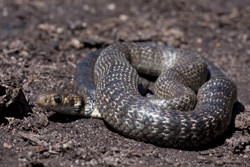Learning from snakes
Upon vascular damage, a cascade of events is triggered that heals the wound and protects from excessive blood loss. Failure of the blood coagulation response leads to life-threatening bleeding disorders such as haemophilia. The formation of a blood clot involves the activation and adhesion of platelets, alongside numerous enzymes and blood coagulation factors. The participating enzymes are large complexes consisting of a protease and a cofactor, which works to enhance the activity of the enzyme. However, our understanding of how these enzymes are brought to the site of injury or how the injured surface propagates the coagulation reactions is incomplete. Coagulation factor V acts as precursor of factor Va, the cofactor for the serine protease Xa that converts prothrombin to thrombin, a key regulatory enzyme in the process. Interaction of Xa with Va dramatically enhances its catalytic rate, highlighting the biological significance of factor V. Seeking to shed light on this process, scientists on the EU-funded 'Molecular regulation of blood coagulation factor V: From snakes to humans' (MOREFV) project set out to provide new information on the molecular mechanisms that regulate the assembly of enzyme cofactors during coagulation. To facilitate this, they employed a novel strategy based on a cofactor found in the venom of the Australian common brown snake Pseudonaja textilis. Interestingly, this cofactor does not require a membrane surface for its enzymatic complex assembly. To determine which region endows the membrane-independent characteristics of snake venom V, researchers generated snake-human chimeras of the blood coagulation cofactor V. Subsequent biochemical analyses of these variants indicated that the snake venom enzyme complex functions in a different way compared to the human equivalent. This finding has opened up new research avenues into the mechanism of enzyme complexes that are essential to blood coagulation. Such information will help develop novel therapeutics and targets to restore haemostasis in cases of a deregulated or overactive coagulation system.







